Social Listening for PR: What Smart Marketers Need to Know
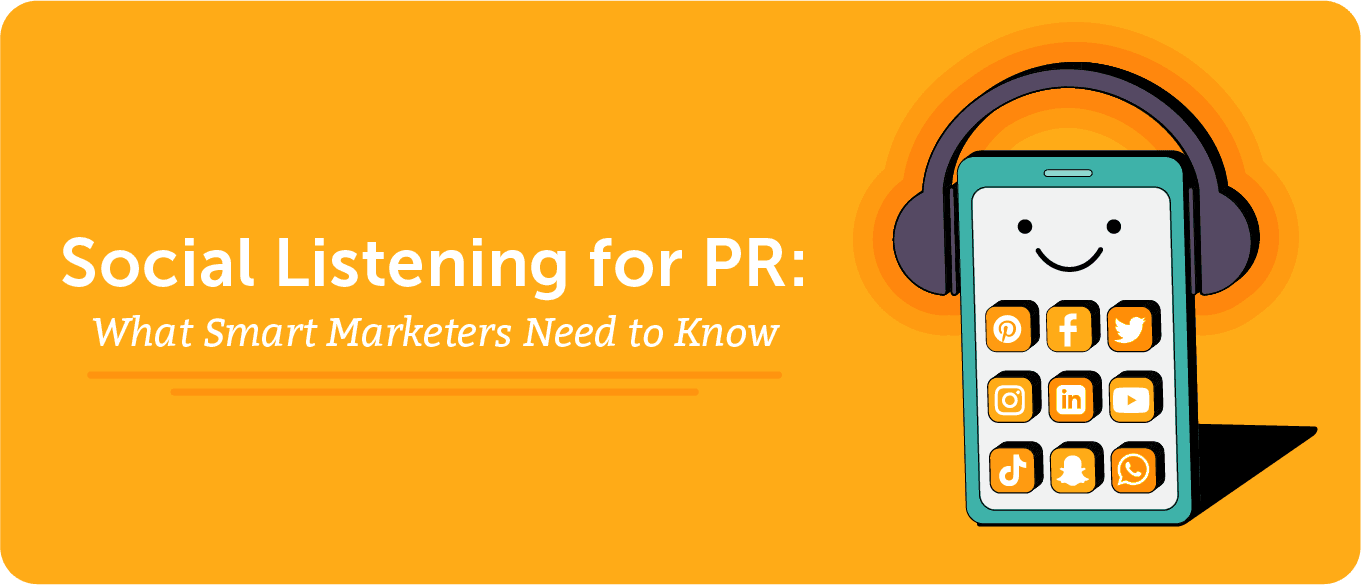 Putting the audience first is a rule marketing and PR pros live by. In pursuit of this, every marketing and PR activity is built around finding target audiences, developing marketing personas, and perfecting buyer personas, where applicable — all with a single aim of staying in touch with the people in which we serve content, products, and services and doing right by them.
Doing right by target audiences is a noble pursuit that also pays off. However, knowing just how well you’re doing is a tricky task that requires a data-based assessment of marketing and PR efforts. While marketing metrics and KPIs are definitive and easily quantifiable, the success of your PR strategy as seen by target audiences is often outside of regular analytics tools’ arsenal.
Where website and social media analytics fail to reach, there’s social listening. Not to sound tacky, but social listening makes everything better. Marketing, PR, sales, SEO, customer support — pick any aspect of running a business and add 24/7, fully-automated monitoring of social media and the web, for real-time audience analysis and performance insights.
It won’t be long until the benefits of social listening become very real.
Putting the audience first is a rule marketing and PR pros live by. In pursuit of this, every marketing and PR activity is built around finding target audiences, developing marketing personas, and perfecting buyer personas, where applicable — all with a single aim of staying in touch with the people in which we serve content, products, and services and doing right by them.
Doing right by target audiences is a noble pursuit that also pays off. However, knowing just how well you’re doing is a tricky task that requires a data-based assessment of marketing and PR efforts. While marketing metrics and KPIs are definitive and easily quantifiable, the success of your PR strategy as seen by target audiences is often outside of regular analytics tools’ arsenal.
Where website and social media analytics fail to reach, there’s social listening. Not to sound tacky, but social listening makes everything better. Marketing, PR, sales, SEO, customer support — pick any aspect of running a business and add 24/7, fully-automated monitoring of social media and the web, for real-time audience analysis and performance insights.
It won’t be long until the benefits of social listening become very real.
It won’t be long until the benefits of social listening become very real.
Click To TweetBefore You Start Reading… Check This Out
It's pretty clear you are interested in Public Relations. I want to share a course from the Actionable Marketing Institute that you may benefit from.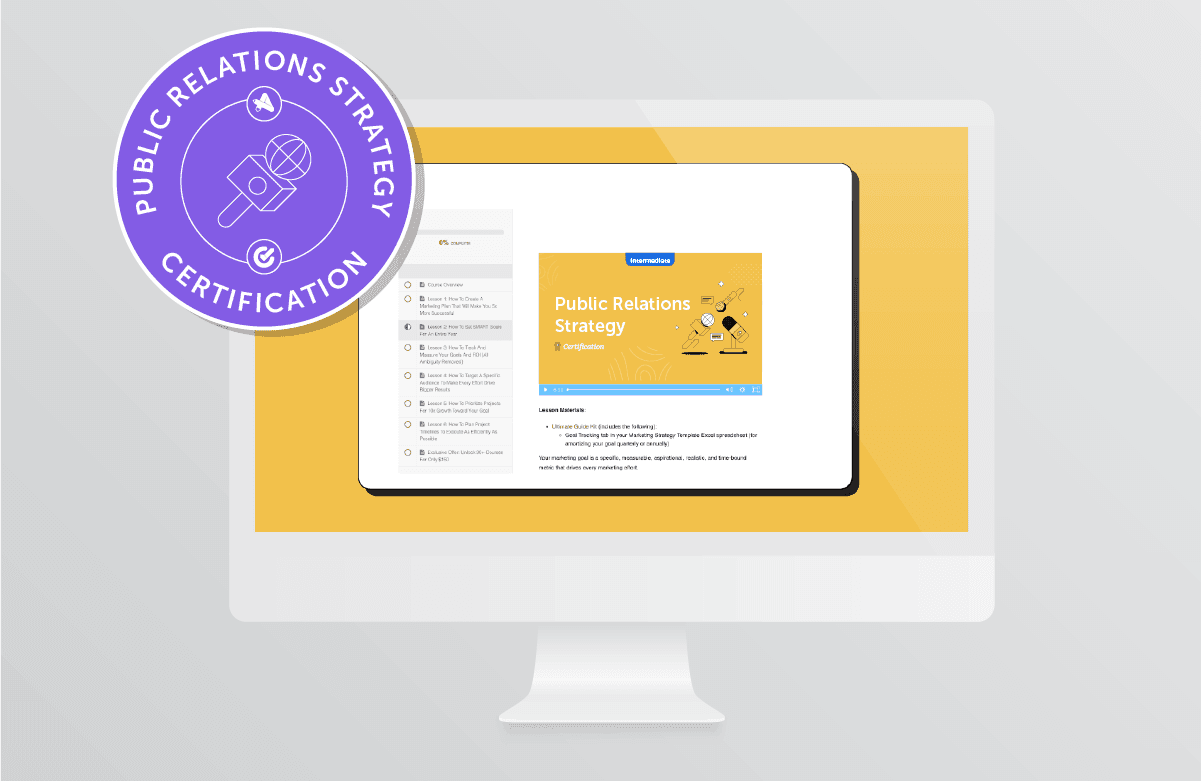 The Public Relations Strategy Certification is a great course to help marketers and business owners learn how to create their own PR strategy. Learn how to plan out a PR strategy using lessons, video tutorials, and templates. Learn more now.
The Public Relations Strategy Certification is a great course to help marketers and business owners learn how to create their own PR strategy. Learn how to plan out a PR strategy using lessons, video tutorials, and templates. Learn more now.
Download Your Social Listening Response Kit
When it comes to social media, not everything is rainbows and butterflies. You need to be prepared for the good AND the bad, so we've put together a couple helpful templates to get you through your social media crises. Take a deep breath; we've got you covered!- Social Media Crisis Planning Template
- Social Media Negative Comment Response Template
What is Social Listening?
As outlined briefly above, social listening is the process of monitoring social media and the web for mentions of any keyword with a dedicated monitoring and analytics tool. Think of it as having a personal superhuman assistant whose only job is to find every online mention of your brand, campaign, product, or whatever it is you’re monitoring, and analyze the data to draw actionable insights.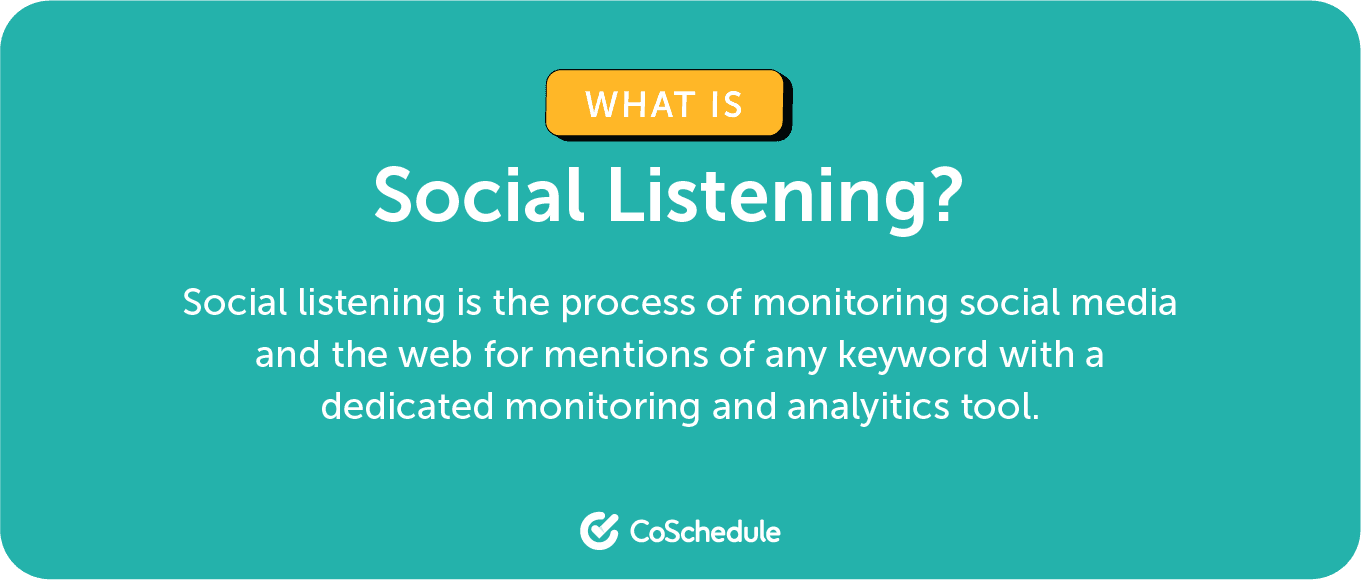 The analytics offered by social listening tools ranges from the sentiment of conversations — like the prevailing tone behind the mentions to the biggest topics, hashtags, and influencers most active in online discussions around your company. These are all valuable, data-driven insights updated in real-time.
Social listening and PR go hand in hand because they’re both focused on the audience. Armed with a social listening tool, you’ll always be in complete sync with the people and institutions un which your PR efforts are targeted.
The analytics offered by social listening tools ranges from the sentiment of conversations — like the prevailing tone behind the mentions to the biggest topics, hashtags, and influencers most active in online discussions around your company. These are all valuable, data-driven insights updated in real-time.
Social listening and PR go hand in hand because they’re both focused on the audience. Armed with a social listening tool, you’ll always be in complete sync with the people and institutions un which your PR efforts are targeted.
Measuring Brand Awareness
Brand awareness is the cornerstone metric of social listening and PR alike.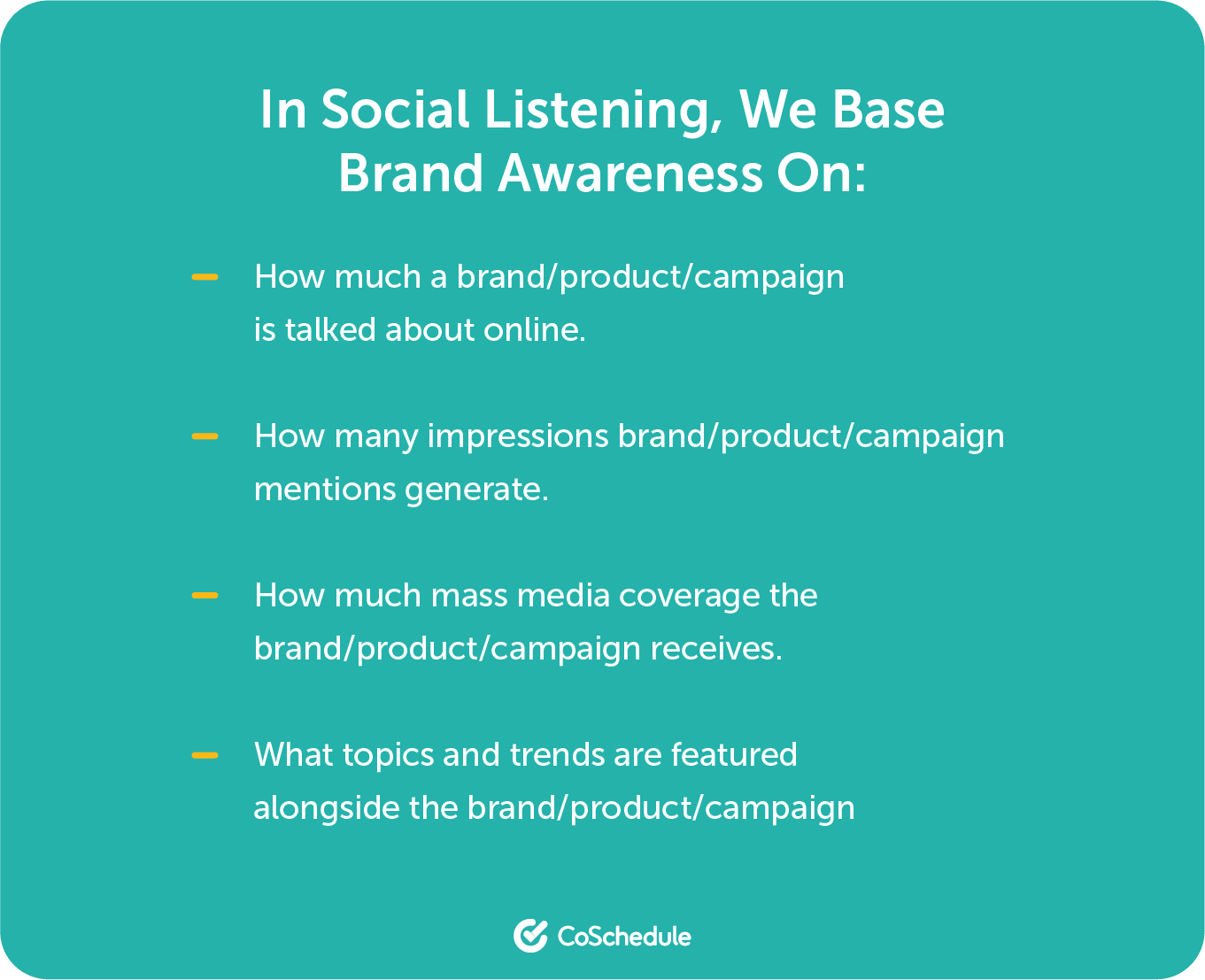 To get an assessment of brand awareness, you need to set your social listening tool to monitor a brand name. This usually requires inputting your brand name and parameters — such as sources, languages, and locations of mentions, as well as the date range and any other filters your tool offers.
To get an assessment of brand awareness, you need to set your social listening tool to monitor a brand name. This usually requires inputting your brand name and parameters — such as sources, languages, and locations of mentions, as well as the date range and any other filters your tool offers.
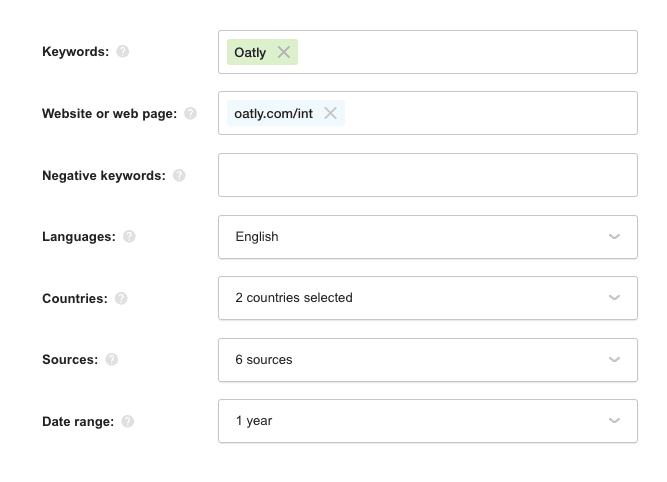 Pro tip: For monitoring common-word or ambiguous brand names, you’ll need a tool with the Boolean search mode.
Social listening is perfect for measuring brand awareness that translates into a share of voice, which correlates to market share. The logic is simple here: the more a company is talked about on social media and the web, the bigger its brand awareness gets.
Robust brand awareness means a bigger share of voice and, consequently, a more prominent place on the market.
Pro tip: For monitoring common-word or ambiguous brand names, you’ll need a tool with the Boolean search mode.
Social listening is perfect for measuring brand awareness that translates into a share of voice, which correlates to market share. The logic is simple here: the more a company is talked about on social media and the web, the bigger its brand awareness gets.
Robust brand awareness means a bigger share of voice and, consequently, a more prominent place on the market.
Monitoring and Managing Reputation
Reputation monitoring and management is another key case of social listening and a major direction of PR activities. In addition to simply monitoring social media and the web, social listening tools perform sentiment analysis and measure brand health.Reputation monitoring and management is a key case of social listening and a major direction of PR activities.
Click To Tweet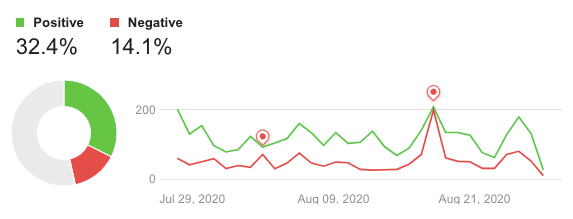 Pro tip: Human language is tricky, and the tone of mentions is not always explicitly positive or negative; social listening tools assign neutral sentiment to some mentions.
To make better sense of brand health, you can calculate net sentiment — a score that determines whether positive or negative sentiment prevails and by how much.
Pro tip: Human language is tricky, and the tone of mentions is not always explicitly positive or negative; social listening tools assign neutral sentiment to some mentions.
To make better sense of brand health, you can calculate net sentiment — a score that determines whether positive or negative sentiment prevails and by how much.
 Social listening tools bring real-time results and notify you of new mentions as often as you like, which means you never miss a shift in brand-related conversations. With this kind of automated, data-supported approach to reputation monitoring, crisis management can be reduced to setting up recurring notifications from your social listening tool.
Social listening tools bring real-time results and notify you of new mentions as often as you like, which means you never miss a shift in brand-related conversations. With this kind of automated, data-supported approach to reputation monitoring, crisis management can be reduced to setting up recurring notifications from your social listening tool.
Gathering Competition Intel
The most valuable and practical PR lessons — first-hand experience aside — come from direct competitors and industry leaders. They operate in the same environment and, therefore, have tested tactics, products, and campaigns you might be considering. Social listening lets you identify industry leaders and keep close tabs on them the same way you keep tabs on your own brand — by setting up continuous mentions monitoring, only this time including competitors’ brand names. Pro tip: When setting up mention monitoring for multiple-word brand names, make sure you put them in quotes to indicate an exact match — just like you would for a regular web search.
When tracking competitor brand names, you’ll be getting all of the insights social listening delivers for your own brand; from the volume and sentiment of mentions to key topics featured alongside the name of a marketing campaign. The beautiful thing about competition analysis with social listening is that you can virtually extract any insights you’re after. As long as it’s somewhere on social media or the web, social listening tools will mine the gold of competition intel.
Pro tip: When setting up mention monitoring for multiple-word brand names, make sure you put them in quotes to indicate an exact match — just like you would for a regular web search.
When tracking competitor brand names, you’ll be getting all of the insights social listening delivers for your own brand; from the volume and sentiment of mentions to key topics featured alongside the name of a marketing campaign. The beautiful thing about competition analysis with social listening is that you can virtually extract any insights you’re after. As long as it’s somewhere on social media or the web, social listening tools will mine the gold of competition intel.
Monitoring Media Coverage
Thorough mass media monitoring is a PR priority that doesn’t lose relevance to this day, only now it’s moved largely to social networks. With social listening, the job that was traditionally entrusted to Google alerts and social media monitoring tools is now automated to perfection with tools that cover both web and social media news — including untagged brand mentions.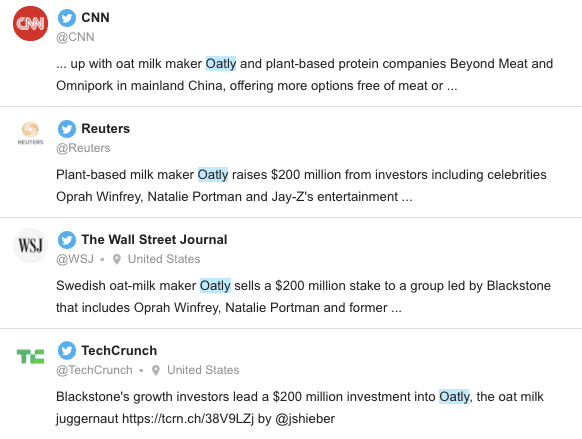 Monitoring the coverage your company receives is the groundwork.
Next step is laying the foundation for a thicker media coverage of upcoming events, product launches, and future campaigns. Social listening tools let you interact with mentions from the media right away or retrieve all contact details needed to reach out to a web-based media outlet. As long as you keep building relationships with industry media, you’ll always know where to pitch your next press release.
Pro tip: Make sure you also check niche publishers working with your competitors and note down some contact names.
Monitoring the coverage your company receives is the groundwork.
Next step is laying the foundation for a thicker media coverage of upcoming events, product launches, and future campaigns. Social listening tools let you interact with mentions from the media right away or retrieve all contact details needed to reach out to a web-based media outlet. As long as you keep building relationships with industry media, you’ll always know where to pitch your next press release.
Pro tip: Make sure you also check niche publishers working with your competitors and note down some contact names.
Engaging Influencers
In the age of digital everything, social media influencers are as powerful of an asset in PR as they are in marketing. When laying out your PR strategy, make sure you include influencer outreach to cover more audience segments. There are many influencer marketing tools designed to bring you opinion leaders and social media influencers. Meanwhile, social listening tools let you set up laser-sharp search for micro-, macro-, and everything in-between types of influencers. With a social listening tool, you get to source influencers three ways.- By monitoring your own brand: Start monitoring your brand name and discover social media influencers among the people already talking about your products or services.
- By monitoring your competitors: Start monitoring your competitors’ brand names and explore their brand ambassadors.
 Naturally, not every company needs to shoot for the big stars. In fact, working with micro-influencers, who are much less of a resource burden, is even more effective when striving for genuine user engagement as opposed to enormous exposure.
What’s important is regardless of the way you choose to identify opinion leaders and potential brand ambassadors, checking their key stats and engaging with them via social listening tools saves time yet brings all the benefits.
Naturally, not every company needs to shoot for the big stars. In fact, working with micro-influencers, who are much less of a resource burden, is even more effective when striving for genuine user engagement as opposed to enormous exposure.
What’s important is regardless of the way you choose to identify opinion leaders and potential brand ambassadors, checking their key stats and engaging with them via social listening tools saves time yet brings all the benefits.
Conducting Audience Analysis
Essentially, all social listening is continuous audience analysis. Every metric comes from raw user data, and you get to fact-check every relevant PR insight by going back to individual posts and social media conversations. As long as you keep mentions monitoring going, you always have a shortcut to your audience — both current and potential. While mentions monitoring your brand, you get real-time updates on how people interact with the content, products, and services you put out there. While monitoring your industry, competitors, and anything niche-specific, you get to tap into new target audiences and markets. From demographic insights, like gender and age to locations and languages — social listening tools give you every audience metric to support your PR strategy.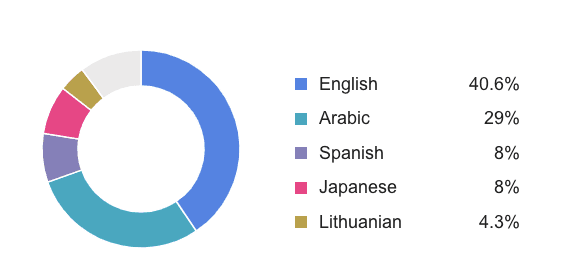 As you get to set up mentions monitoring for anything words can say, social listening empowers you to run audience research of any scope.
Here are some examples of targeted audience research you can do with social listening:
As you get to set up mentions monitoring for anything words can say, social listening empowers you to run audience research of any scope.
Here are some examples of targeted audience research you can do with social listening:
- What topics resonate best with your audiences?
- What kind of products and services are in demand?
- What market segments are under-served by your competitors?


